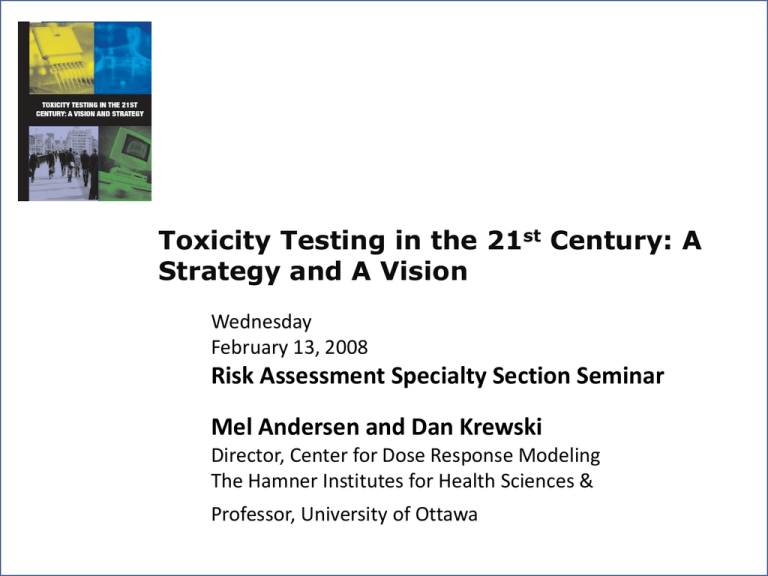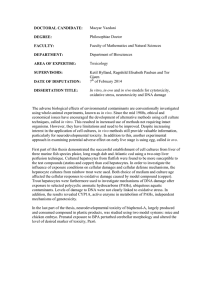Toxicity Testing in the 21 Century: A Strategy and A Vision
advertisement

Toxicity Testing in the 21st Century: A Strategy and A Vision Wednesday February 13, 2008 Risk Assessment Specialty Section Seminar Mel Andersen and Dan Krewski Director, Center for Dose Response Modeling The Hamner Institutes for Health Sciences & Professor, University of Ottawa Toxicity Testing in the 21st Century: A Vision and Strategy Committee on Toxicity Testing and Assessment of Environmental Agents Board on Environmental Studies and Toxicology Institute for Laboratory Animal Research Division on Earth and Life Studies National Research Council Committee Roster Daniel Krewski (Chair), University of Ottawa, Ottawa, ON Daniel Acosta, Jr., University of Cincinnati, Cincinnati, OH Melvin Andersen, CIIT Centers for Health Research, Research Triangle Park, NC Henry Anderson, Wisconsin Division of Public Health, Madison, WI John Bailar III, University of Chicago, Chicago, IL Kim Boekelheide, Brown University, Providence, RI Robert Brent, Thomas Jefferson University, Wilmington, DE Gail Charnley, HealthRisk Strategies, Washington, DC Vivian Cheung, University of Pennsylvania, Philadelphia, PA Sidney Green, Howard University, Washington, DC Karl Kelsey, Harvard University, Boston, MA Nancy Kerkvliet, Oregon State University, Corvallis, OR Abby Li, Exponent, Inc., San Francisco, CA Lawrence McCray, Massachusetts Institute of Technology, Cambridge MA Otto Meyer, Danish Institute for Food and Veterinary Research, Søborg, Denmark D. Reid Patterson, Reid Patterson Consulting, Inc., Grayslake, IL William Pennie, Pfizer, Inc., Groton, CT Robert Scala, Exxon Biomedical Sciences (Ret.), Tucson, AZ Gina Solomon, Natural Resources Defense Council, San Francisco, CA Martin Stephens, The Humane Society of the United States, Washington, DC James Yager, Jr., Johns Hopkins University, Baltimore, MD Lauren Zeise, California Environmental Protection Agency, Oakland, CA Content June 12, 2007 Design a ‘modern’ toxicity testing program to assess potential human risks posed by exposures to environmental agents over a broad range of doses and compounds and to be in a position to use this information in quantitative human health risk assessment. Design Criteria For New Approaches A fundamental re-direction in toxicity testing is needed to achieve the following design criteria: • To develop a more robust scientific basis for assessing health • • • effects of environmental agents (mechanistic data) To provide broad coverage of chemicals, chemical mixtures, outcomes, and life stages To reduce the cost and time of testing To base decisions on human rather than rodent biology and focus on more relevant dose levels Current Paradigm: The Exposure-response Continuum Exposure Tissue Dose Biologically Effective Dose Physiologically Based Pharmacokinetic Models Early Responses Tissue Dose Metric Late Responses Pathology Mode of Action Pharmacokinetics Pharmacodynamics A New Paradigm: Activation of Toxicity Pathways Exposure Tissue Dose Biologic Interaction Low Dose Higher Dose Higher yet Perturbation Normal Biologic Function Biologic Inputs Early Cellular Changes Adaptive Stress Responses Cell Injury Morbidity and Mortality Toxicity Pathways Toxicity Pathway: A cellular response pathway that, when sufficiently perturbed, is expected to result in an adverse health effect. Toxicity Pathways Endogenous hormones DNA damage PXR, CAR, PPAR and AhR receptors Hypo-osmolarity Nrf2 oxidative stress Heat-shock proteins P38 MAPK Antioxidant Response Pathway Normally, Nrf2 is bound to the cytoplasmic protein Keap1 When challenged with oxidant stressors, Nrf2 is released, going to the nucleus and guides expression of antioxidant stress genes Integration of Cell Signaling Pathways Mitogen-activated protein kinase (MAPK) cascades integrate cell signaling pathways that govern cell kinetics Computational Systems Biology Cytosol Catalase H2O2 H2O2 H2O O2 Peroxisome H2O2 Keap1 H2O2 Φ Keap1o GCL Φ export r-GC GSSG Keap1o Syn Nrf2 H2O GSH NADP Keap1 export GPx H2O2 Nrf2-Keap1o Nrf2-Keap1 GS GR NADPH G6PD Φ + Nrf2 Nucleus Φ Maf Nrf2-Maf ARE(GR) Nrf2-Maf -ARE(GR) GRoff GRon Nrf2-Maf ARE(GCL) Nrf2-Maf -ARE(GCL) GCLoff GCLon Nrf2-Maf ARE(HO-1) Nrf2-Maf -ARE(HO-1) HO-1off HO-1on GR mRNA GR Φ Φ GCL mRNA GCL Φ Φ HO-1 mRNA HO-1 Φ Φ + Feedback controlled adaptive stress responses govern activation and perturbation of signaling pathways Dose-response Modeling of Nrf2 Pathway Activation Response Nfr2 activation represents an important biological perturbation of a general “toxicity pathway”. Need tools to assess dose response. dose Options for Future Toxicity Testing Strategies Option I In Vivo Option II Tiered In Vivo Option III In Vitro/In Vivo Option IV In vitro Animal biology Animal biology Primarily human biology Primarily human biology High doses High doses Broad range of doses Broad range of doses Low throughput Improved throughput High and medium throughput High throughput Expensive Less expensive Less expensive Less expensive Time consuming Less time consuming Less time consuming Less time consuming Relative large number of animals Fewer animals Substantially fewer animals Virtually no animals Apical endpoints Apical endpoints Perturbations of toxicity pathways Perturbations of toxicity pathways Some in silico and in vitro screens In silico screens possible In silico screens Options for Future Toxicity Testing Strategies Option I In Vivo Option II Tiered In Vivo Option III In Vitro/In Vivo Option IV In vitro Animal biology Animal biology Primarily human biology Primarily human biology High doses High doses Broad range of doses Broad range of doses Low throughput Improved throughput High and medium throughput High throughput Expensive Less expensive Less expensive Less expensive Time consuming Less time consuming Less time consuming Less time consuming Relative large number of animals Fewer animals Substantially fewer animals Virtually no animals Apical endpoints Apical endpoints Perturbations of toxicity pathways Perturbations of toxicity pathways Some in silico and in vitro screens In silico screens possible In silico screens Options for Future Toxicity Testing Strategies Option I In Vivo Option II Tiered In Vivo Option III In Vitro/In Vivo Option IV In vitro Animal biology Animal biology Primarily human biology Primarily human biology High doses High doses Broad range of doses Broad range of doses Low throughput Improved throughput High and medium throughput High throughput Expensive Less expensive Less expensive Less expensive Time consuming Less time consuming Less time consuming Less time consuming Relative large number of animals Fewer animals Substantially fewer animals Virtually no animals Apical endpoints Apical endpoints Perturbations of toxicity pathways Perturbations of toxicity pathways Some in silico and in vitro screens In silico screens possible In silico screens Options for Future Toxicity Testing Strategies Option I In Vivo Option II Tiered In Vivo Option III In Vitro/In Vivo Option IV In vitro Animal biology Animal biology Primarily human biology Primarily human biology High doses High doses Broad range of doses Broad range of doses Low throughput Improved throughput High and medium throughput High throughput Expensive Less expensive Less expensive Less expensive Time consuming Less time consuming Less time consuming Less time consuming Relative large number of animals Fewer animals Substantially fewer animals Virtually no animals Apical endpoints Apical endpoints Perturbations of toxicity pathways Perturbations of toxicity pathways Some in silico and in vitro screens In silico screens possible In silico screens Options for Future Toxicity Testing Strategies Option I In Vivo Option II Tiered In Vivo Option III In Vitro/In Vivo Option IV In vitro Animal biology Animal biology Primarily human biology Primarily human biology High doses High doses Broad range of doses Broad range of doses Low throughput Improved throughput High and medium throughput High throughput Expensive Less expensive Less expensive Less expensive Time consuming Less time consuming Less time consuming Less time consuming Relative large number of animals Fewer animals Substantially fewer animals Virtually no animals Apical endpoints Apical endpoints Perturbations of toxicity pathways Perturbations of toxicity pathways Some in silico and in vitro screens In silico screens possible In silico screens Components of the Vision Chemical Characterization EPA’s ToxCastTM Program Toxicity Testing High Throughput Screening 10’s/year 100’s/year 1-3/year 10,000’s/day 100,000’s/day High Throughput Molecular mechanism Implementing the Vision: NIH National Chemical Genomics Center Enzymatic assays Receptor binding assays GTPγS binding Assays Tissue culture assays Cell-based Elisa and Western Blots (for quantitative antigen detection ) FLIPR™ Assays (GPCR and ion channel targets) Various reporter based assays NIEHS HTS Assays • Apoptosis Assays – Caspase-Glo® 3/7 Assay – Caspase-Glo® 9 Assay – Caspase-Glo® 8 Assay • Cytotoxicity Assays – CellTiter-Glo® Luminescent Cell Viability Assay (measures ATP levels) – Cytotox-ONE™Homogeneous Membrane Integrity Assay (measures release of lactate dehydrogenase from membrane-damaged cells) • P-glycoprotein (Pgp) ATPase Assay (aka MDR1 or ABCB1) – Pgp-Glo™ Assay Dose-Response and Extrapolation Modeling Response Dose-Response and Extrapolation Modeling dose Biologically Based Dose Response Models N 1 1 2 I A Biologically Motivated Model for Cancer M Capture dosedependencies of main processes although lacking in specific biological detail. Has been challenging to understand doseresponse with topdown approaches Computational Systems Biology Model for the Circuitry and the Output Cytosol Catalase H2O2 H2O2 Circuitry model developed for all key assays to support dose response assessment, from bottom up H2O O2 Peroxisome H2O2 Keap1 H2O2 Φ Keap1o GCL Φ export r-GC GSSG Keap1o Syn Nrf2 H2O GSH NADP Keap1 export GPx H2O2 Nrf2-Keap1o Nrf2-Keap1 GS GR NADPH G6PD Φ + Nrf2 + Nucleus Φ Maf ARE(GR) Nrf2-Maf -ARE(GR) GRoff GRon Nrf2-Maf ARE(GCL) Nrf2-Maf -ARE(GCL) GCLoff GCLon Nrf2-Maf ARE(HO-1) Nrf2-Maf -ARE(HO-1) HO-1off HO-1on GR mRNA GR Φ Φ GCL mRNA GCL Φ Φ HO-1 mRNA HO-1 Φ Φ Response Nrf2-Maf dose In vitro to in vivo extrapolations with PK and PBPK models Cin alveolar space Cout lung blood rapidly perf. tissue deep fat fat lipidLipid poolPool Blood liver metabolism Venous blood Arterial blood slowly perf. tissue Implementation of Strategy Comprehensive suite of in vitro tests, preferably based on human cells, cell lines, or components. Computational models of signal transduction in toxicity pathways to support application of in vitro test results in risk assessments. Physiologically based pharmacokinetic (PBPK) models to assist in vitro to in vivo extrapolations Validation of toxicity pathway tests and test strategies Method Development Focus Methods to predict metabolism Chemical-characterization & in silico tools High throughput assays Appropriate number of assays Approaches to uncover cell circuitry Mechanistic models for pharmacokinetics and for perturbations of cell signaling pathways Infrastructure A long-term, large-scale concerted effort is needed to bring the vision to fruition. An appropriate institutional structure that fosters multidisciplinary intramural and extramural research is needed to achieve the vision. The effort will not succeed merely by creating a virtual institution to link and integrate organizations that perform relevant research. Toxicity Testing in relation to the 1983 Risk Assessment Red Book Chemical Characterization Dose Response Assessment Mode of Action Compounds Affected Pathway Assess Biological Perturbation Metabolite(s) Population Based Studies Dose Response Analysis for Perturbations of Toxicity Pathways Calibrating in vitro and human Dosimetry Measures of dose in vitro Human Exposure Data Hazard Identification Risk Characterization Exposure Assessment Exposure Guideline Regulatory Context Shift in focus away from apical outcomes in experimental animals towards important perturbations of toxicity pathways Development of risk assessment practices based on pathway perturbations Re-interpretation or possible re-writing of regulatory statues under which risk assessments are conducted Assessing Levels of Activation of Toxicity Pathways Associated with overt Toxicity Exposure Tissue Dose Biologic Interaction Low Dose Higher Dose Higher yet Perturbation Normal Biologic Function Biologic Inputs Early Cellular Changes Adaptive Stress Responses Cell Injury Morbidity and Mortality What it is and what it isn’t Approach based on in vitro, high throughput, mechanistic tests to assess perturbations of ‘toxicity pathways’ of relevance for human biology and to interpret them in a dose-response context Perturbations assessed over wide range of doses and interpreted in relation to exposures that are not expected to cause significant perturbations of these key pathways IT IS NOT an approach to use suites of in vitro tests to predict high dose animal toxicity. In this manner, its goals are different from those of ECVAM, ICCVAM, the US EPA ToxCast, or the NIEHS high throughput initiatives. Conclusions Paradigm shift away from apical endpoints in test animals to perturbation of toxicity pathways in human cells Providing much broader coverage of the universe of environmental agents that warrant our attention Has consequences for toxicity testing and in the search for alternatives to animal testing Already, at this point in time, this vision is an applied sciences problem rather than a research-driven process Topsy-turvy compared to present: testing in vitro based – research in vivo based






